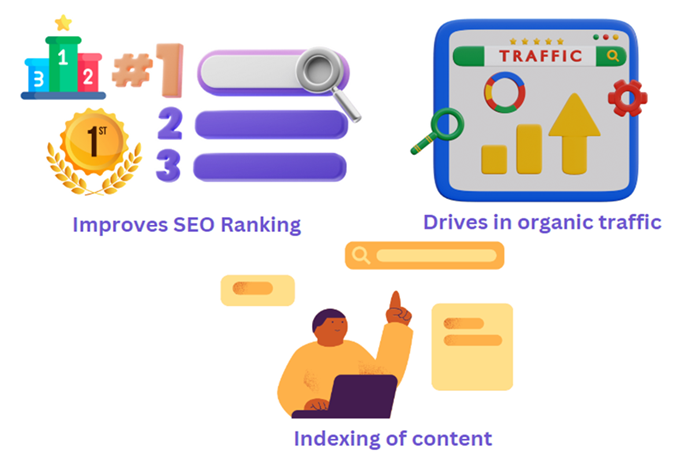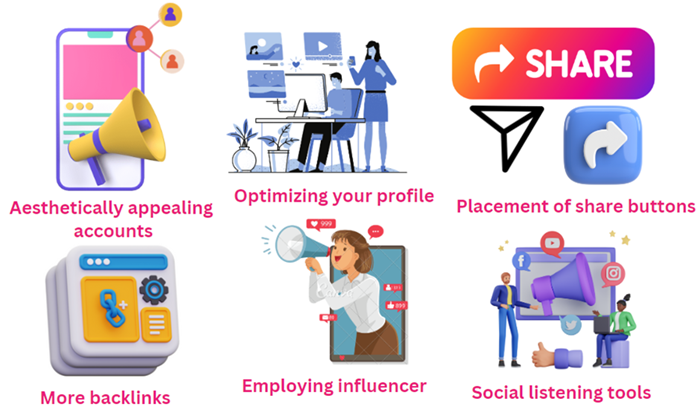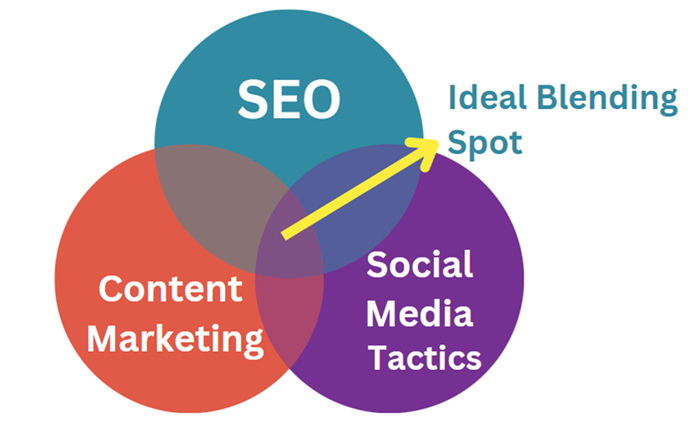
- SEO - Home
- SEO - What is SEO?
- SEO - Tactics & Methods
- SEO - On Page Techniques
- SEO - Off Page Techniques
- SEO - Web Site Domain
- SEO - Relevant Filenames
- SEO - Design & Layout
- SEO - Optimized Keywords
- SEO - Long-tail Keywords
- SEO - Title Tags
- SEO - Meta Description
- SEO - Optimized Metatags
- SEO - Optimize for Google
- SEO - Robots.txt
- SEO - URL Structure
- SEO - Headings
- SEO - Redirects
- SEO - Authority & Trust
- SEO - PDF Files
- SEO - Optimized Anchor
- SEO - Optimize Images
- SEO - Duplicate Content
- SEO - Meta Robots Tag
- SEO - Nofollow Links
- SEO - XML Sitemap
- SEO - Canonical URL
- SEO - Role of UI/UX
- SEO - Keyword Gap Analysis
- SEO - Get Quality Backlinks
- SEO - Adding Schema Markup
- SEO - Author Authority
- SEO - Fix Broken Links
- SEO - Internal Page Linking
- SEO - Clean Up Toxic Links
- SEO - Earn Authority Backlinks
- SEO - Core Web Vitals
- SEO - Update Old Content
- SEO - Fill Content Gaps
- SEO - Link Building
- SEO - Featured Snippets
- SEO - Remove URLS from Google
- SEO - Content is the King
- SEO - Verifying Web Site
- SEO - Multiple Media Types
- SEO - Google Passage Ranking
- SEO - Maximize Social Shares
- SEO - First Link Priority Rule
- SEO - Optimize Page Load Time
- SEO - Hiring an Expert
- SEO - Learn EAT Principle
- SEO - Mobile SEO Techniques
- SEO - Avoid Negative Tactics
- SEO - Misc Techniques
- SEO - Continuous Site Audit
- SEO - Summary
- SEO Useful Resources
- SEO - Quick Guide
- SEO - Useful Resources
- SEO - Discussion
SEO - Maximize Social Shares
Social media serves a vital role in helping businesses get their products or services in the sights of a larger audience. This leads to a variety of SEO perks, such asmore backlinks, increased engagement, and an outstanding dedicated SERP for brand queries.
Furthermore, knowing SEO and online marketing helps businesses function better on both platforms. Social media audience analysis allows you to generate better-focused content. SEO research may assist you in determining what your social crowd wants to consume and fill content gaps.
Social SEO: What Is It?
Social SEO is the use of social media networks as an indirect method to increase the website's visibility and ranking.
While the use of social networking sites has no immediate effect on SEO, social evidence (likes, shares, and comments) generated through individuals sharing the posts on social media help to build authority and client loyalty, and also improve brand recognition and exposure, each of which help in boosting the visibility and traffic to the website.
Why Is It Essential To Boost Social Shares?
Social Media Can Assist You in Improving SEO Ranking Signals
Even if social shares aren't a ranking component, time on the page and site most certainly is. As a result, numerous respondents believe that social media improves SEO by supporting you in improving the factors that affect rankings.
Social Shares bring in organic Traffic
Sharing on social media may be a highly successful approach for gaining more website traffic which helps boost SEO, particularly in the early days when a website has just debuted.
Posting and sharing on social media
It accelerates the indexing of content, improve SEO ranking and drives in organic traffic.

How to Increase Social Shares for SEO?
Create aesthetically appealing social media accounts and content
Humans are very visual beings. Customers may visit a website and depart because the material or formatting is outdated, wrong, or bad.
Customers have various platforms and accounts to select from, so you must use your content best to draw in them. To learn what works best for your audience, experiment with several sorts of content, such as blogs, videos, endorsements, etc.
Also, utilize good imagery associated with your brand so that people can identify it as yours when they see it. This will boost brand identification and awareness.
OptimizeYour Profile
Wherever you have a social media page, it must be completely filled out andoptimized. Take time to complete the profile to guarantee that the material being shared comes from a reliable and high-quality source.
Comprehensive profiles − Incomplete profiles might make customers question who you are and what your companydoes. Include as many facts as possible to provide a complete picture of the job your company performs.
Use a single photo, handle, and bio (if feasible) for every platform to ensure you're readily available and identifiable.
Diversity − Ensure that your business is well-known on all relevant social media platforms.
Make yourself discoverable − Conduct keyword research and ensure your profile appears in social media search engines.
Check links − Ensure all media is functioning properly before and after posting.
Optimizeinfographics − Each social network has its own set of optimum dimensions and quality constraints, so stay on top of these.
Place your share buttons wisely
You mustoptimisethe positioning of the share icons to ensure your readers see them and are inspired toclick on them.
Bring attention to your buttons − You want to avoid an essential call-to-action, such as share buttons, being overshadowed by clutter.Make them stand out from the rest of the material on the page.
Don't make people scroll too far − Users frequently scan posts or opt to share before finishing them. If your material necessitates a lot of scrolling, place it near the top or side.
Avoid dead zones − Users devote less attention to certain portions of a website. Heat mapping tools, like CrazyEgg may help you determine which portions of your website visitors connect with and which parts they ignore.
Encourage backlinks with quality content
People will only share material they feel is valuable or relevant to their target audience. If time and resources are limited, choosing quality over quantity is wise.
To demonstrate authority, research issues and include significant studies and third-party links with internal links. Quotes from professionals or data that support your viewpoint are also appropriate.
Above all, acquire a tone and point of view on your sector to assist you in becoming a thought leader.
Consider employing influencers and paying attention to them
Influencers have power on social media, as you are undoubtedly aware. To find out how much, glance at the influencer statistics.
You don't have to set lofty goals for your influencer marketing approach. Still, if you're aware of influencers in your industry or location that your target audience listens to, it can be worth considering employing them on social media.
Use social listening tools to discover what's happening with your competition and others.
Social listening is an effective SEO strategy, and several free solutions are available. These will assist you in monitoring discussions to understand what your intended market has to say about you and keep track of your rivals.
People increasingly turn to social media to ask queries and check reviews (and complaints), so keeping an eye on your platforms is a bright idea for handling online reviews and general customer service.

Impact of Social Shares On SEO
Social media sharing has no direct influence on SEO. However, sharing your material on social media might have the following effects on SEO −
Increase organic traffic
Boost visibility
Improve your local SEO
Increase brand recognition by expanding content reach
Increase the number of backlinks
Establish authority
How to Merge SEO with Social Media?
Locating the blending spot − The initial step is to locate the ideal site. The perfect location is the point at which your SEO, marketing of content, and social media tactics intersects and complement one another.
You can generate effective blog postings and guides (how-to guides). Podcasts with texts and videos or create infographics to reach this ideal spot.

Using topic clusters − Topic clusters are an excellent way to organise your material and include SEO in your overall content strategy. Essentially, an important topic and multiple sub-topics branch out from it.
The principal subject in a topic cluster is known as the pillar content. The cluster content is made up of the sub-topics. Employ hyperlinks to connect your pillar and cluster information when arranging your material.

Conclusion
Sharing material on social media makes it more discoverable and extends its lifetime as others share it. Your content planning and strategy for social media, as well as statistics for both, must function in tandem. It would be best to create engaging material that people are inclined to discuss and share.